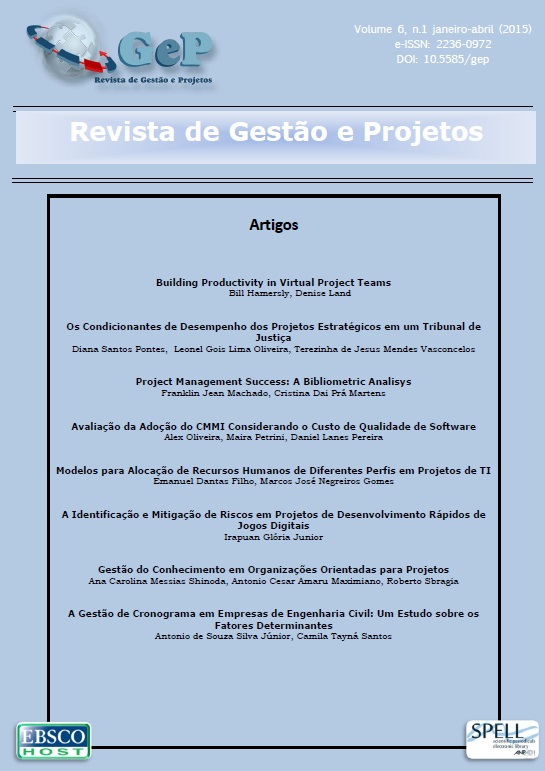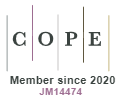Building Productivity in Virtual Project Teams
DOI:
https://doi.org/10.5585/gep.v6i1.305Palavras-chave:
Project, Project Management, Governance, Communication, Strategy, Diversity, Structure, Virtual, Virtuality, Virtual Project Teams.Resumo
The steady increase in project failure rates is leaving businesses searching for better integration techniques to virtualize their project environments. Through virtualization, organizations may have positive impacts on communities across geographical boundaries and resource constraints. The focus of this phenomenological study was to explore, via the experiences of successful project management practitioners, best practice strategies for integrating virtual project teams through data analysis. The conceptual framework included von Bertalanffy’s general systems theory, decomposition model of business process and project management frameworks, and the recomposition approach. Twenty-two senior project managers with more than 5 years of experience managing virtual project environments participated in semistructured telephone interviews. The van Kaam process employing normalization and bracketing approaches in data analysis resulted in the emergence of 34 thematic categories. The 10 most common themes culminated in the identification of strategies relevant for virtual project teams. The major themes pertained to 3 broad areas: (a) structure that accommodates skills and technology for virtual team success, (b) governance leading to efficient virtual project team management, and (c) collaboration practices across diverse environments. This study involved the exploration of the experiences of the participants. Using the van Kaam method for normalization of the data and clustering like experiences into thematic statements, the study provided a plethora of new information concentrated on 10 themes that emerged.
Referências
Allen, J. P., & Geller, D. (2012). Open source deployment in local government. Information Technology & People, 25, 136-155. doi:10.1108/09593841211232631
Anantatmula, V. S., & Shrivastav, B. (2012). Evolution of project teams for Generation Y workforce. International Journal of Managing Projects in Business, 5(1), 9-26. doi:10.1108/17538371211192874
Andersen, E. S. (2012). Illuminating the role of the project owner. International Journal of Managing Projects in Business, 5(1), 67-85. doi:10.1108/17538371211192900
Andersen, S. S., & Dag, V. H. (2013). Knowledge development and transfer in a mindful project-organization. International Journal of Managing Projects in Business, 6, 236-250. doi:10.1108/17538371311319007
Brandt, V., England, W., & Ward, S. (2011). Virtual teams. Research Technology Management, 54(6), 62-63. Retrieved from http://www.iriweb.org
Bullen, P., & Love, P. (2011). A new future for the past: A model for adaptive reuse decision-making. Built Environment Project and Asset Management, 1(1), 32-44. doi:10.1108/20441241111143768
Bulley, C. A., Baku, K. F., & Allan, M. M. (2014). Competitive intelligence information: A key business success factor. Journal of Management and Sustainability, 4(2), 82-91. Retrieved from http://www.ccsenet.org/journal/index.php/jms
Cavaleri, S., Firestone, J., & Reed, F. (2012). Managing project problem-solving patterns. International Journal of Managing Projects in Business, 5(1), 125-145. doi:10.1108/17538371211192937
Cooper, R. G., & Edgett, S. J. (2012). Best practices in the idea-to-launch process and its governance. Research Technology Management, 55(2), 43-54. doi:10.5437/08956308X5502022
Coughlan, T. (2014). Enhancing innovation through virtual proximity. Technology Innovation Management Review, 4(2), 17-22. Retrieved from http://timreview.ca/
Crespo, F. A., Pedamallu, C. S., Özdamar, L., & Weber, G. W. (2012). Contribution to the collaborative work in virtual organization - a case study. Organizacija, 45(5), 228. doi:10.2478/v10051-012-0023-3
Datsenko, Y., & Schenk, J. (2013). Leading clinical projects. Applied Clinical Trials, 22(1), 24-28. Retrieved from http://www.appliedclinicaltrialsonline.com/
Demirag, I., & Khadaroo, I. (2011). Accountability and value for money: A theoretical framework for the relationship in public-private partnerships. Journal of Management & Governance, 15, 271-296. doi:10.1007/s10997-009-9109-6
Devos, J., Hendrik, V. L., & Deschoolmeester, D. (2012). Rethinking IT governance for SMEs. Industrial Management + Data Systems, 112, 206-223. doi:10.1108/02635571211204263
Espinosa, A., & Porter, T. (2011). Sustainability, complexity, and learning: Insights from complex systems approaches. The Learning Organization, 18(1), 54-72. doi:10.1108/09696471111096000
Gaan, N. (2012). Collaborative tools and virtual team effectiveness: An inductively derived approach in India’s software sector. Decision, 39(1), 5-27. Retrieved from http://billygraham.org/decision-magazine/
Gallego-Álvarez, I., Prado-Lorenzo, J. M., & García-Sánchez, I-M. (2011). Corporate social responsibility and innovation: A resource-based theory. Management Decision, 49, 1709-1727. doi:10.1108/00251741111183843
Gressgård, L. J. (2011). Virtual team collaboration and innovation in organizations. Team Performance Management, 17(1), 102-119. doi:10.1108/13527591111114738
Gunnarsson, J., & Wallin, T. (2011). An evolutionary approach to regional systems of innovation. Journal of Evolutionary Economics, 21, 321-340. doi:10.1007/s00191-010-0208-y
Hahn, I., Bredillett, C., Gyeung-Min, K., & Taloc, M. (2012). Agility of a project manager in a global is project. The Journal of Computer Information Systems, 53(2), 31-38. Retrieved from http://www.iacis.org/jcis/jcis.php
Hans, J. T. (2011). Critical success factors for managing technology-intensive teams in the global enterprise. Engineering Management Journal, 23(3), 30-36. Retrieved from http://asem.org/asemweb-emj.html
Hanson, J. L., Balmer, D. F., & Giardino, A. P. (2011). Qualitative research methods for medical educators. Academic Pediatric Association, 11, 375-386. doi:10.1016/j.acap.2011.05.001
Harding, J. S. (2014). Seven tools for project success. Chemical Engineering, 121(1), 36-41. Retrieved from http://www.che.com/
Hauc, A., Vrecko, I., & Barilovic, Z. (2011). A holistic project – Knowledge society as a condition for solving global strategic crisis. Drustvena Istrazivanja, 20, 1039-1060. Retrieved from http://hrcak.srce.hr/drustvena-istrazivanja
Hulya, J. Y. (2011). Significance of organizational culture in perceived project and business performance. Engineering Management Journal, 23(2), 20-29. Retrieved from http://asem.org/asemweb-emj.html
Iverson, S. V., & Drake, J. (2014). The handbook of high-performance virtual teams: A toolkit for collaborating across boundaries. New Horizons in Adult Education & Human Resource Development, 26(2), 63-66. Retrieved from http://www.editlib.org/j/ISSN-1939-4225/
Jang, C,-Y. (2013). Facilitating trust in virtual teams: The role of awareness. Advances in Competitiveness Research, 21(1), 61-77. Retrieved from http://www.eberly.iup.edu/ASCWeb/journals_acr.html
Janssen, M., & Klievink, B. (2012). Can enterprise architectures reduce failure in development projects? Transforming Government: People, Process and Policy, 6(1), 27-40. doi:10.1108/17506161211214804
Jarratt, D., & Thompson, J. (2012). Virtual business models to address real world strategic challenges. Emergence: Complexity and Organization, 14(2), 1-24. Retrieved from http://emergentpublications.com/
Kapoor, B., & Sherif, J. (2012). Human resources in an enriched environment of business intelligence. Kybernetes, 41(10), 1625-1637. doi:10.1108/03684921211276792
Kornfeld, B. J., & Kara, S. (2011). Project portfolio selection in continuous improvement. International Journal of Operations & Production Management, 31, 1071-1088. doi:10.1108/01443571111172435
Kovach, J. V., & Mariani, J. (2012). Exploring quality initiatives' success and failure. The Journal for Quality and Participation, 35(3), 24-28. Retrieved from http://asq.org/pub/jqp/
Kruger, C. J., & Mavis, N. M. (2012). Incorporating business strategy formulation with identity management strategy formulation. Information Management & Computer Security, 20, 152-169. doi:10.1108/09685221211247271
Lohle, M. F., & Terrell, S. R. (2014). Real projects, virtual worlds: Coworkers, their avatars, and the trust conundrum. The Qualitative Report, 19(8), 1-35. Retrieved from http://www.nova.edu/ssss/QR/
Lundberg, K. (2011). A systems thinking approach to environmental follow-up in a Swedish central public authority: Hindrances and possibilities for learning from experience. Environmental Management, 48(1), 123-133. doi:10.1007/s00267-010-9600-5
MacKenzie, K., Buckby, S., & Irvine, H. (2013). Business research in virtual worlds: Possibilities and practicalities. Accounting, Auditing & Accountability Journal, 26(3), 352-373. doi:10.1108/09513571311311856
Macnaghten, P., & Owen, R. (2011). Good governance for geoengineering. Nature, 479(73), 293. Retrieved from http://www.nature.com/
Madsen, A. K. (2013). Virtual acts of balance: Virtual technologies of knowledge-management as co-produced by social intentions and technical limitations. Electronic Journal of E-Government, 11(2), 183-197. Retrieved from http://www.ejeg.com/main.html
Marabelli, M., Rajola, F., Frigerio, C., & Newell, S. (2013). Managing knowledge in large-scale virtual projects: A community-based approach. International Journal of Managing Projects in Business, 6, 310-331. doi:10.1108/17538371311319043
Martinic, A., Fertalj, K., & Kalpic, D. (2012). Methodological framework for virtual team project management. International Journal of Innovation, Management and Technology, 3, 702. Retrieved from http//www.ijimt.org/
Mathur, G., Jugdev, K., & Tak, S. F. (2013). Project management assets and project management performance outcomes. Management Research Review, 36, 112-135. doi:10.1108/01409171311292234
Maylor, H. R., Turner, N. W., & Murray-Webster, R. (2013). How hard can it be? Research Technology Management, 56(4), 45-51. Retrieved from http://www.scimagojr.com/journalsearch.php?q=22949&tip=sid
Medvedeva, T. A. (2012). Developing an innovative style of thinking and innovative behavior. Systemic Practice and Action Research, 25(3), 261-272. doi:10.1007/s11213-011-9221-9
Morris, P. W. G. (2012). Cleland and king: Project management and the systems approach. International Journal of Managing Projects in Business, 5, 634-642. doi:10.1108/17538371211268951
Mostafavi, A., Abraham, D. M., & Lee, J. (2012). System-of-systems approach for assessment of financial innovations in infrastructure. Built Environment Project and Asset Management, 2, 250-265. doi:10.1108/20441241211280927
Moustakas, C. (1994). Phenomenological research methods. Thousand Oaks, CA: Sage Publications, Inc.
Moutinho, J. A., & Kniess, C. T. (2012). Contributions of a project management office in a laboratory of R&D of a public university. Revista De Gestão e Projetos, 3(2), 282. Retrieved from http://www.revistagep.org/ojs/index.php/gep
Mulej M., Potocan, V., Zenko, Z., Kajzer, S., Ursic, D., & Knez-Riedl, J. (2004). How to restore bertalanffian systems thinking. Kybernetes, 33(1), 48-61. Retrieved from http://www.emeraldinsight.com/loi/k
Ofori, D. F. (2013). Project management practices and critical success factors-A developing country perspective. International Journal of Business and Management, 8(21), 14-31. Retrieved from http://www.theijbm.com/
Oktavera, R., & Saraswati, R. (2012). Framework for implementation project portfolio selection decision in a shipping company. Academic Research International, 3(3), 163-174. Retrieved from http://www.journals.savap.org.pk/
Pacuraru, R. (2012). Virtual organizations. Economics, Management and Financial Markets, 7(4), 695-702. Retrieved from http://www.addletonacademicpublishers.com/economics-management-and-financial-markets
PMI. (2014). PMI’s pulse of the profession: The high cost of low performance. Retrieved from http://www.pmi.org/Pulse
Rahmansyah, R., & Ford, L. G. (2013). Service oriented architecture governance implementation in a software development project as an enterprise solution. Journal of Computer Science, 9(12), 1638-1647. Retrieved from http://thescipub.com/journals/jcs
Reed, A. H., & Knight, L. V. (2013). Project duration and risk factors on virtual projects. The Journal of Computer Information Systems, 54, 75-83. Retrieved from http://www.iacis.org/jcis/jcis.php
Richards, D., & Bilgin, A. (2012). Cross-cultural study into ICT student attitudes and behaviours concerning teams and project work. Multicultural Education & Technology Journal, 6(1), 18-35. doi:10.1108/17504971211216292
Riemer, K., & Vehring, N. (2012). Virtual or vague? a literature review exposing conceptual differences in defining virtual organizations in is research. Electronic Markets, 22, 267-282. doi:10.1007/s12525-012-0094-2
Schoemaker, P. J., Krupp, S., & Howland, S. (2013). Strategic leadership: The essential skills. Harvard Business Review, 91(1), 131-134. Retrieved from www.harvardbusiness.org
Sheffield, J., Sankaran, S., & Haslett, T. (2012). Systems thinking: Taming complexity in project management. On the Horizon, 20(2), 126-136. doi:10.1108/10748121211235787
Smet, D. D., & Mention, A. (2012). Inducing service innovations through the governance of IT-enabled projects. Journal of Management Research, 4(4), 1-16. Retrieved from http://www.macrothink.org/journal/index.php/jmr
Smith, D., & Sonnenblick, R. (2013). From budget-based to strategy-based portfolio management. Research Technology Management, 56(5), 45-51. Retrieved from www.iriweb.org/Main/Library/RTM_Journal/
Söderlund, J. (2012). Project management, interdependencies, and time. International Journal of Managing Projects in Business, 5, 617-633. doi:10.1108/17538371211268924
Staadt, J. (2012). Redesigning a project-oriented organization in a complex system. International Journal of Managing Projects in Business, 5(1), 51-66. doi:10.1108/17538371211192892
Stephens, A. (2013). Principled success. International Journal of Managing Projects in Business, 6(1), 199-209. doi:10.1108/17538371311291099
Vinayan, G., Jayashree, S., & Marthandan, G. (2012). Critical success factors of sustainable competitive advantage: A study in Malaysian manufacturing industries. International Journal of Business and Management, 7(22), 29-45. Retrieved from http://www.theijbm.com/
von Bertalanffy, L. (1968). General systems theory: Foundations, developments, applications (Revised edition). New York, NY: George Braziller, Inc.
Wang, B., & Moon, Y. B. (2013). Hybrid modeling and simulation for innovation deployment strategies. Industrial Management + Data Systems, 113(1), 136-154. doi:10.1108/02635571311289719
Wesner, M. S., & Hobgood, A. S. (2012). Virtual collaboration: Exploring the process and technology in a graduate course. Organization Development Journal, 30(3), 29-39. Retrieved from http://www.scimagojr.com/journalsearch.php?q=3900148507&tip=sid
White, D., & Fortune, J. (2012). Using systems thinking to evaluate a major project. Engineering, Construction and Architectural Management, 19(2), 205-228. doi:10.1108/09699981211206124
Yasir, M., & Majid, A. (2013). A methodical study of the role of trust at various development stages of virtual organizations. Journal of Information Systems & Operations Management, 1-10. Retrieved from http://jisom.rau.ro/forward.html
Yeow, J., & Edler, J. (2012). Innovation procurement as projects. Journal of Public Procurement, 12, 472-504. Retrieved from http://www.fau.edu/pprc/research/jopp.php
Yu, C-I., Chen, H-G., Klein, G., & James, J. J. (2013). Risk dynamics throughout the system development life cycle. The Journal of Computer Information Systems, 53(3), 28-37. Retrieved from http://www.iacis.org/jcis/jcis.php
Ziemba, E. (2013). The holistic and systems approach to the sustainable information society. The Journal of Computer Information Systems, 54, 106-116. Retrieved from http://www.iacis.org/jcis/jcis.php







